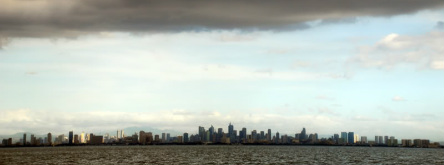Manila -- the capital of the Philippines
Manila is often described as the only capital city in Asia that’s not exotically Asian.
It is one of the sixteen cities that comprise Metro Manila.
Manila has a total population of more than 1,652,171 according to the 2010 census. It is the second most populous city in the Philippines, behind its neighbor, Quezon City.
The populace inhabit an area of only 38.55 square kilometers, making Manila the most densely populated city in the world.
History:
Manila was first known as Gintô (gold) or Suvarnadvipa, and was officially, "The Kingdom of Maynila."
The city was already Islamized by the 15th century, and was home to Muslim-Malays, who were descended from the Arabs, Indians, East Asians and other Southeast Asians.
Manila was temporarily threatened by the invasion of the Chinese, which flourished during the latter half of the Ming Dynasty as a result of direct trade relations with China.
When the Spanish arrived, Manila became the capital of the country and the center of Spanish activity in the Far East and one end of the Manila-Acapulco Galleon trade route inking Latin America and Asia.
Manila has always been sought after because of its strategic location between China together with the rest of Asia, and Mexico - the next closest transit point for goods onwards from Asia to Europe. This caused it to be called the "Pearl of the Orient".
As part of the Spanish East Indies, Manila eventually become the seat of the colonial government of Spain. Spain would control for over three centuries, from 1565 to 1898.
In 1898, Spain ceded the Philippines (along with Puerto Rico and Guam) to the United States. Under American control, the new government attempted to create Manila as Paris on the Prairie.
Manila fell to the hands of the Japanese on January 2, 1942, it was recaptured by the joint American and Filipino troops in March 1945.
Asia's oldest:
In Manila can be found the world's oldest Chinatown thriving before the arrival of the Spaniards in 1571 and the city's original center for business, finance, and wholesale, as well as retail trade
University of Santo Tomas, Asia's oldest university (founded in 1611).
The Manila Zoo, Asia's oldest zoo.
Manila is where the Malacañan Palace is located, the official executive seat and residence of the sitting Philippine President as well as museum. It is also the birthplace of the famous San Miguel Beer.
Languages:
One may detect a hodge podge of languages including, English, Spanish, Malay, Sanskrit, Arabic, & Chinese.
Hokkien is widely spoken while Mandarin might also be known as it is taught in Chinese educational institutions. It is fast becoming the third most important language following Filipino and English, unseating Spanish.
Spanish used to be the official language of the Philippines and deteriorated to the language of the old time generations.
It is one of the sixteen cities that comprise Metro Manila.
Manila has a total population of more than 1,652,171 according to the 2010 census. It is the second most populous city in the Philippines, behind its neighbor, Quezon City.
The populace inhabit an area of only 38.55 square kilometers, making Manila the most densely populated city in the world.
History:
Manila was first known as Gintô (gold) or Suvarnadvipa, and was officially, "The Kingdom of Maynila."
The city was already Islamized by the 15th century, and was home to Muslim-Malays, who were descended from the Arabs, Indians, East Asians and other Southeast Asians.
Manila was temporarily threatened by the invasion of the Chinese, which flourished during the latter half of the Ming Dynasty as a result of direct trade relations with China.
When the Spanish arrived, Manila became the capital of the country and the center of Spanish activity in the Far East and one end of the Manila-Acapulco Galleon trade route inking Latin America and Asia.
Manila has always been sought after because of its strategic location between China together with the rest of Asia, and Mexico - the next closest transit point for goods onwards from Asia to Europe. This caused it to be called the "Pearl of the Orient".
As part of the Spanish East Indies, Manila eventually become the seat of the colonial government of Spain. Spain would control for over three centuries, from 1565 to 1898.
In 1898, Spain ceded the Philippines (along with Puerto Rico and Guam) to the United States. Under American control, the new government attempted to create Manila as Paris on the Prairie.
Manila fell to the hands of the Japanese on January 2, 1942, it was recaptured by the joint American and Filipino troops in March 1945.
Asia's oldest:
In Manila can be found the world's oldest Chinatown thriving before the arrival of the Spaniards in 1571 and the city's original center for business, finance, and wholesale, as well as retail trade
University of Santo Tomas, Asia's oldest university (founded in 1611).
The Manila Zoo, Asia's oldest zoo.
Manila is where the Malacañan Palace is located, the official executive seat and residence of the sitting Philippine President as well as museum. It is also the birthplace of the famous San Miguel Beer.
Languages:
One may detect a hodge podge of languages including, English, Spanish, Malay, Sanskrit, Arabic, & Chinese.
Hokkien is widely spoken while Mandarin might also be known as it is taught in Chinese educational institutions. It is fast becoming the third most important language following Filipino and English, unseating Spanish.
Spanish used to be the official language of the Philippines and deteriorated to the language of the old time generations.


